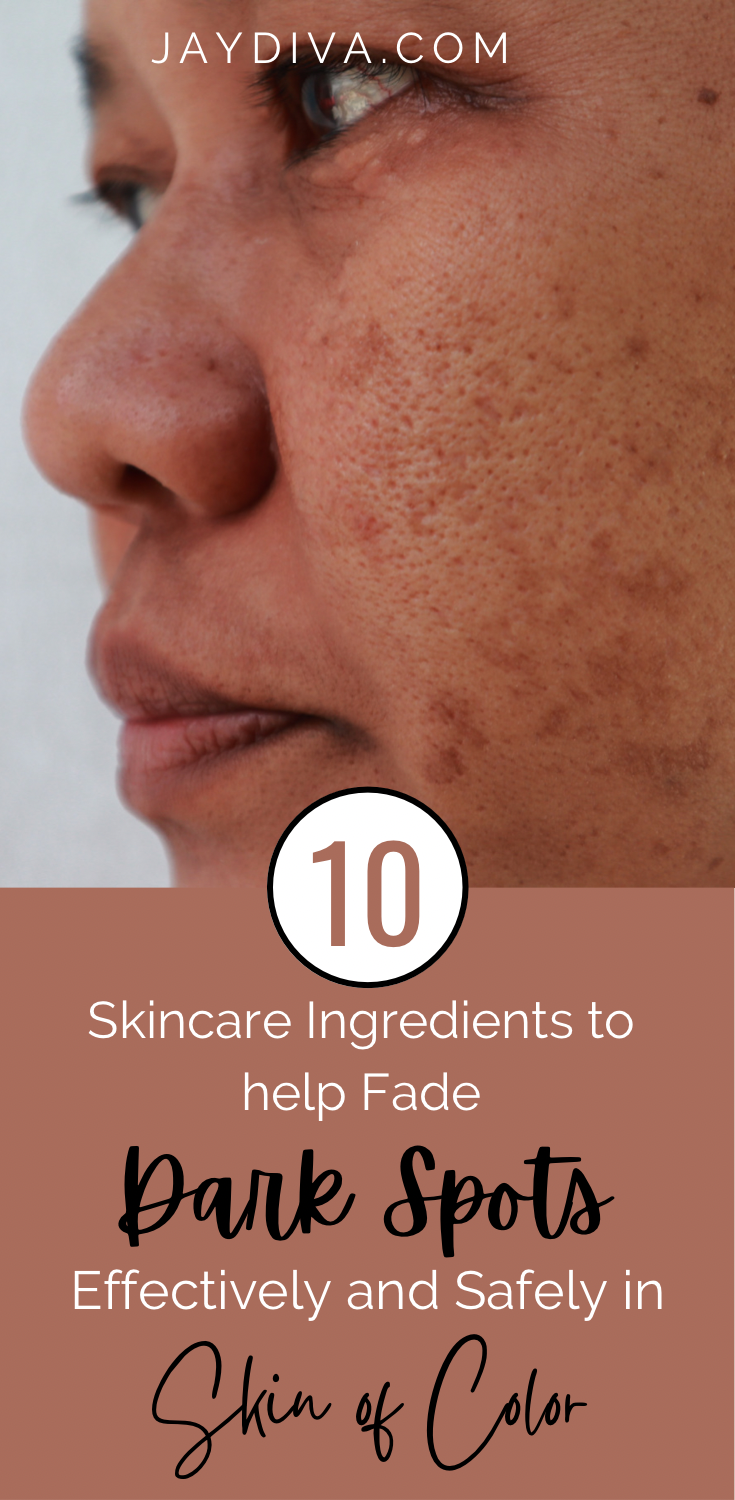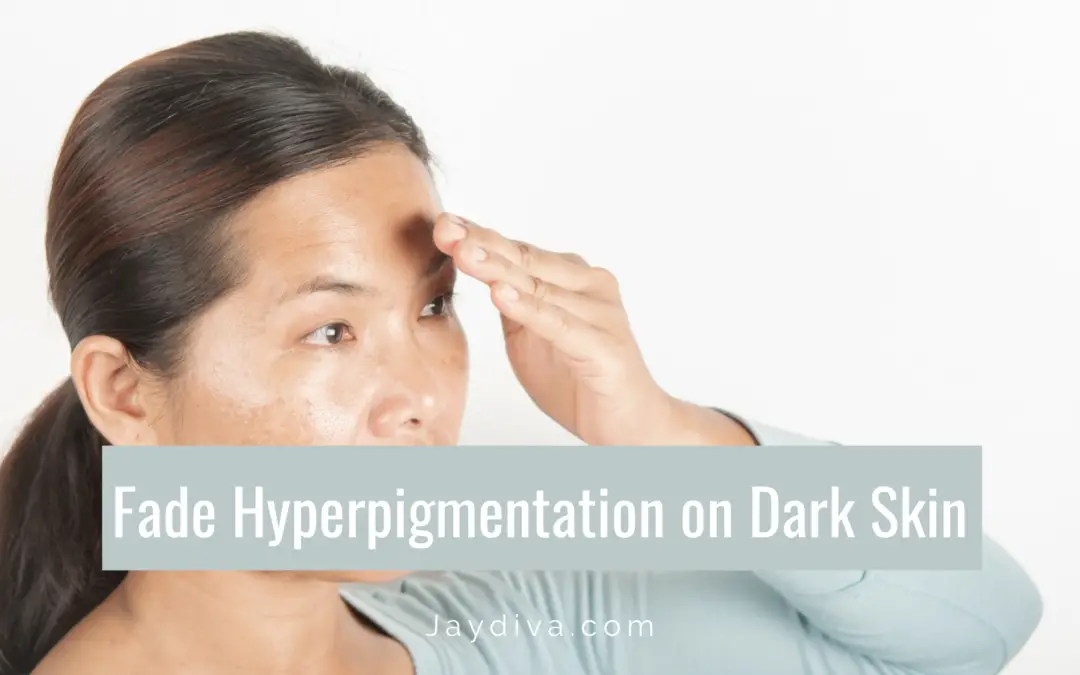Post-inflammatory hyperpigmentation(PIH) is the dark marks that are left after our skin heals from an injury or irritation to the skin. These dark marks tend to occur commonly and are more difficult to treat on dark skin. This is due to the presence of more melanin( the pigment responsible for our skin color). In addition, the melanocytes in dark skin are more sensitive than in other skin types. This is a follow-up post on how to prevent and treat post-inflammatory hyperpigmentation on dark skin. In this post, I will be sharing 10 amazing skincare ingredients to help fade post-inflammatory hyperpigmentation on black skin.
so as usual grab a cup of coffee, tea, or something….and let’s dive in
This post contains affiliate links, we earn a commission when you purchase through these links at no additional cost to you.
WATCH VIDEO:
Table of Contents
10 Skincare Ingredients For PIH on Black Skin
Getting rid of post-inflammatory hyperpigmentation on dark skin can be very tricky. If done wrongly can leave you with a much worse rebound post-inflammatory hyperpigmentation.
Pin For Later!

It is important to note that all skincare ingredients for hyperpigmentation leave your skin prone to sunburns. UV rays also induce melanogenesis( melanin production). In order to effectively combat hyperpigmentation, we need to use sunscreens daily.
RELATED POSTS:
- How to prevent and treat post-inflammatory hyperpigmentation on dark skin
- 5 best skincare ingredients for oily acne-prone skin
Below are the top 10 skincare ingredients to get rid of hyperpigmentation on dark skin:
1. Vitamin C
Vitamin C is a powerhouse when it comes to skincare. It’s an important skincare ingredient to have in your morning skincare routine.
Vitamin C serves a lot of beneficial functions: It’s an antioxidant, meaning it fights free radical damage. ( free radicals are unpaired electrons which ideally should be paired, so they move about looking for electrons to stabilize themselves. They cause cell damage and this is evident on the skin as premature signs of aging, age spots, fine lines, and wrinkles). So using a vitamin c serum can boost the effectiveness of your sunscreen.
Vitamin C also has anti-tyrosinase activities and so can prevent melanin formation. Regular use of vitamin C will gradually fade dark spots and brighten out the skin.
2. Lactic acid
Lactic acid is an alpha hydroxy acid. It is formed from fermented milk. Lactic acid is mild and so is ideal for use for those with sensitive skin. lactic acid is packed with a lot of skin benefits. It is a keratolytic agent( meaning it breaks down keratin and encourages dead skin cells to shed), when this happens, damaged and hyperpigmented skin falls off revealing younger, brighter, and more even-toned skin. Its a also humectant ( meaning it can draw water from the atmosphere to the skin to keep it hydrated.
3. Alpha Arbutin
Alpha arbutin is a natural alternative to hydroquinone. It is extracted from bearberries, blueberries, and cranberries.
It is an antioxidant and skin brightener. It is also a tyrosinase inhibitor and It provides a similar result to hydroquinone without the added side effects and this has led to its increasing popularity in the skincare community in recent times.
Hydroquinone is a bleaching agent and is the gold standard in lightening hyperpigmentation. It lightens areas of hyperpigmentation by interrupting the formation of melanin by inhibiting the enzyme tyrosinase needed for its synthesis. Hydroquinone is marketed over the counter in 2% strengths while prescription strengths can go all the way to 4%. It is not safe for use in pregnancy and in nursing mothers.
The big downside to using hydroquinone is its propensity to cause severe rebound hyperpigmentation called exogenous ochronosis. The rebound hyperpigmentation usually arises from skin irritations, dryness, and sensitivity, and when the skin heals it is left with these areas of hyperpigmentation. Sunburns from leaving the skin unprotected also contribute to this as well, and there have been concerns in the past concerning its ability to leave you prone to skin cancers and for this reason, it has been banned in many countries.
Alpha arbutin works best when paired with other skin Brighteners like vitamin C, kojic acid, and niacinamide
4. Azelaic Acid
This is another skincare ingredient that is been hugely raved about currently in the skincare community and for good reason.
Azelaic acid is a naturally occurring acid that not only brightens the skin but is anti-inflammatory. This is a gold mine for people with oily acne-prone skin who form dark spots easily. Azelaic acid is used in the treatment of acne and rosacea.
5. Salicylic Acid
This is a beta-hydroxy acid, derived from willow bark. Salicylic acid is thbark. Salicylic acid is the number one skincare ingredient you should have in your skincare routine if you are oily and acne-prone. it can calm skin irritation, slough off dead skin cells, and clean out your pores. when your pores are unclogged they appear smaller. The gradual shedding of the top layer of the skin allows younger, more vibrant, clear skin to shine through.
6. Tranexamic acid
Tranexamic acid is the new kid on the block of skin brighteners. Though fairly new in the skincare community, it is commonly used in the treatment of menorrhagia. It is a synthetic derivative of the amino acid lysine. It is another tyrosinase inhibitor with anti-inflammatory properties as well.
Tranexamic acid works well with other skincare ingredients like vitamin C, retinol. Tranexamic not only treats existing hyperpigmentation but can also prevent post-inflammatory Hyperpigmentation.
7. Niacinamide
Niacinamide is also known as Vitamin B3 is an antioxidant with skin brightening properties. It repairs the skin barrier, controls sebum production, lightens hyperpigmentation, and cleans out the pores making them appear smaller.
8. Licorice
Licorice is a herb used in Chinese medicine. Its powerhouse is its root. The licorice root extract has antioxidant, anti-inflammatory properties and can lighten areas of hyperpigmentation.
It owes its antioxidant and anti-inflammatory properties to glycyrrhizin which is the substance responsible for its sweet taste. It also contains Glabridin which is responsible for its skin brightening properties.
9. Retinoids
Retinoid is a term used to describe vitamin A derivatives. Retinoids are one of my favorite skincare ingredients. I have seen a huge improvement in my skin texture since introducing a retinoid to my skincare routine. they work by increasing the rate of skin cell turnover. This high cell turnover causes the fading of dark marks and acne scars.
Some retinoids are over the counter while others are not. Tretinoin which is the gold standard retinoid is a prescription medication in many countries. Retinoids you can get over the counter include adapalene, retinol, and retinaldehyde.
Retinoids have been known to cause a lot of dryness, redness, and peeling. So it’s wise to start slow. If you have sensitive skin, you may want to start with milder retinoids like retinol and adapalene.
10. Kojic Acid
Kojic acid is a common skin lightening ingredient found in skin brightening creams. It is derived from mushroom-like fungi during fermentation. It inhibits melanin production. Like most skin brightening ingredients, it can cause some sensitivity like dryness, redness, and itching.
Final take Home
Due to the tendency of black skin to develop rebound hyperpigmentation following treatment of dark spots on the skin, It is pertinent to be careful with the skincare ingredients and concentration of these skincare ingredients in products used to treat these dark spots.






















